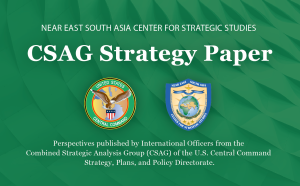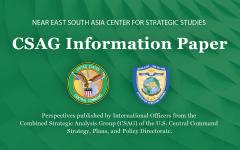CSAG Strategy Paper: Water Scarcity Triple Threat: Trigger, Weapon, and Casualty of Violence in the CENTCOM AOR
August 27, 2025 2025-08-27 21:31CSAG Strategy Paper: Water Scarcity Triple Threat: Trigger, Weapon, and Casualty of Violence in the CENTCOM AOR
CSAG Strategy Paper: Water Scarcity Triple Threat: Trigger, Weapon, and Casualty of Violence in the CENTCOM AOR
CSAG STRATEGY PAPER
COL Jerzy KANIA POL Army (CSAG/CCJ5)
21 August 2025

Introduction:
Water is essential for human survival and the cornerstone of civilizations, cultures, and economies. This is most keenly felt in dry regions like the Middle East. In this water-scarce area, where temperatures often soar and rainfall is rare, access to water is a critical factor for life, continued development, and a peaceful environment. The Middle East’s rivers, aquifers, and desalinated seawater sustain the region’s basic needs and its agricultural sectors, which are vital for food security.
Water also supports key industries, from oil and gas to tourism, and significantly influences geopolitics in the region. Control over water resources has historically been a source of both cooperation and conflict. As increasing temperatures and population growth intensify water scarcity, the need for sustainable water management and equitable distribution becomes ever more pressing. Water, especially its scarcity, is and will continue to be a significant contributor to conflicts in the Middle East, and its impact is likely to worsen in the coming years, posing significant challenges to regional stability and security.
The aim of this paper is to highlight the critical role of water in the Middle East’s geopolitical landscape and the urgent need for sustainable water management to prevent and mitigate conflicts. By examining the region’s severe water scarcity, rapid population growth, and transboundary water disputes, the paper underscores the necessity for comprehensive strategies involving regional cooperation, infrastructure investment, and diplomatic efforts to avoid increasing waters issues as a destabilizing factor in the region. The paper explores how water serves as a trigger for conflicts, a weapon in disputes, and a casualty of war, emphasizing the multifaceted ways in which water insecurity exacerbates and multiplies tensions and violence in the region. Urgently addressing these issues will avoid future conflicts in the region.
Key Points:
- Water’s multifaceted role in global conflicts is undeniable, as it can be wielded as a weapon, act as a trigger for hostilities, and become a casualty of violence.
- Water scarcity is exacerbating existing tensions and further fueling conflicts in the region, with some countries competing for access to limited water resources as an existential threat.
- Violent extremist organizations (VEOs) are exploiting water scarcity to further their goals, using water as a weapon to control populations and territory.
- The deliberate targeting of water infrastructure is being used as a tactic of warfare, deepening conflict and instability in the region.
- Long-term options to address these challenges include urgently needed implementation of transboundary water management agreements, investing in water infrastructure, and promoting water conservation and efficiency practices.
- Key will be enhancement of regional water security and resilience by protecting vital infrastructure, fostering cross-border cooperation, delivering aid, and planning for crises. USCENTCOM can play a vital role in strengthening the Middle East’s ability to withstand and respond to water-related threats and challenges.
View other USCENTCOM Combined Strategic Analysis Group (CSAG) papers here.
The opinions and conclusions expressed herein are those of a number of international officers within the Combined Strategic Analysis Group (CSAG) and do not necessarily reflect the views of United States Central Command, not of the nations represented within the CSAG or any other governmental agency.



